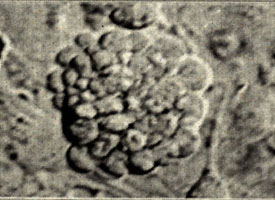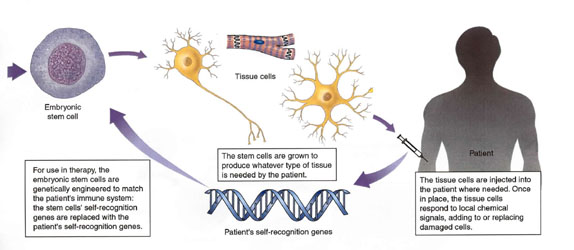Tissue-Specific Adult Stem Cells
New results promise a neat way around the ethical maze presented by stem cells derived from embryos. Go back for a moment to what we were saying about how a human child develops. What happens next to the embryonic stem cells? They start to take different developmental paths. Some become destined to form nerve tissue and, after this decision is taken, cannot ever produce any other kind of cell. They are then called nerve stem cells. Others become specialized to produce blood, still others muscle. Each major tissue is represented by its own kind of tissue-specific stem cell (figure 48.6). Now heres the key point: as development proceeds, these tissue-specific stem cells persist. Even in adults. So why not use these adult cells, rather than embryonic stem cells?
Transplanted Tissue-Specific Stem Cells Cure MS in Mice
In pathfinding 1999 laboratory experiments by Dr. Evan Snyder of Harvard Medical School, tissue-specific stem cells were able to restore lost brain tissue. He and his co-workers injected neural stem cells (immediate descendants of embryonic stem cells able to become any kind of neural cell) into the brains of newborn mice with a disease resembling multiple sclerosis (MS). These mice lacked the cells that maintain the layers of myelin insulation around signal-conducting nerves. The injected stem cells migrated all over the brain, and were able to convert themselves into the missing type of cell. The new cells then proceeded to repair the ravages of the disease by replacing the lost insulation of signal-conducting nerve cells. Many of the treated mice fully recovered. In mice at least, Tissue-specific stem cells offer a treatment for MS.
Human embryonic stem cells. Stem cells removed from a six-day blastocyst can be established in culture and then maintained indefinitely. (Photo: Paul Hosefros, NYT 8/11/01, page A8)
The approach seems very straight forward, and should apply to humans. Indeed blood stem cells are already routinely used in humans to replenish the bone marrow of cancer patients after marrow-destroying therapy. The problem with extending the approach to other kinds of tissue-specific stem cells is that it has not always been easy to find the kind of tissue-specific stem cell you want.
Transplanted tissue-specific stem cells may allow us to replace damaged or lost tissue, offering cures for many disorders that cannot now be treated while avoiding the ethical problems posed by embryonic stem cells.

